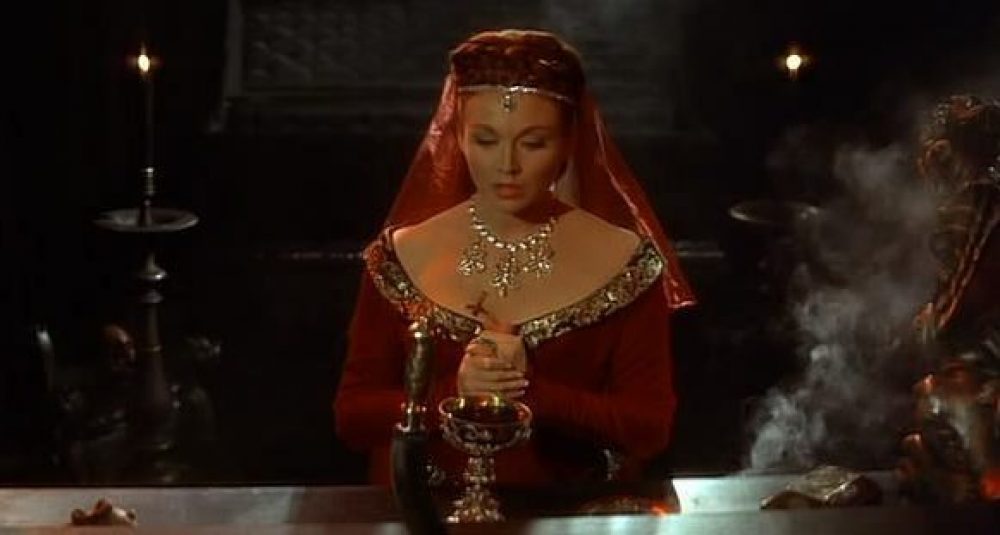By: H.B.G.
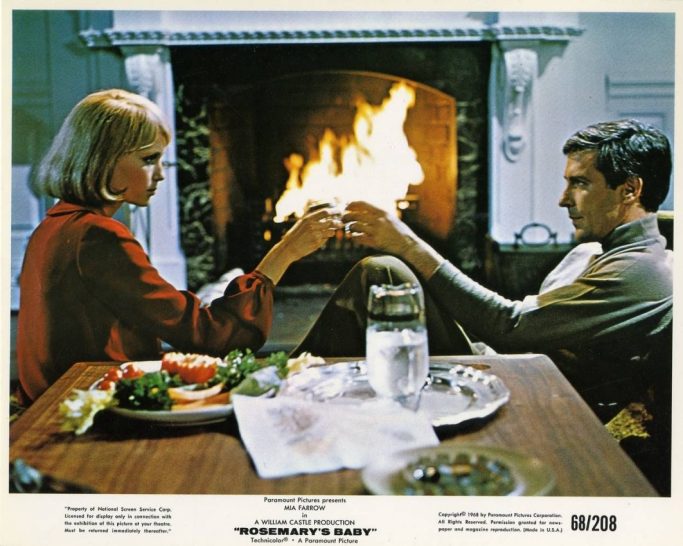
Mia Farrow and John Cassavetes toast to an imminent conception with far-reaching effects.
Caution: This article contains some spoilers! If you have not read the novel or seen the film (what the Hell are you waiting for?!) you might want to save reading this article until after you have!
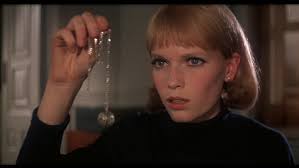
In 1967 American culture was exploding on all levels. This was the year of the so-called “Summer of Love”. The Civil Rights Movement headed by Martin Luther King Jr. was in full swing, as was the Vietnam War, the Sexual revolution, and activism for Women’s Rights. Andy Warhol was making instant movie stars in The Factory. Timothy Leary, a psychologist and researcher with the Harvard Center for Research in Personality who oversaw Harvard’s Psilocybin Project, instructed a crowd of 30, 000 hippies gathered in San Francisco’s Golden Gate Park to “Turn on, tune in, drop out.” LSD drenched Rock ‘n Roll and psychedelic art was unleashed as an endless parade of young, long haired hippies and flower children, defying all social norms, made transcendental pilgrimages – both near and far – towards a purple-hazy ideal of freedom. Young men were burning their draft cards and the youth in general were motivated towards social change while shaking off the grip of their families long-held belief systems. Things were drastically changing! Utopia was at hand!
An exotic and colorful bouquet of new cults, old religions, gurus and esoteric magic in the Age of Aquarius burst upon the scene: Moonies, Hare Krishnas, Occultism, TM, Scientology, Jim Jones, and the Process Church to name just a few. At the same time, Charles Manson was lurking in San Francisco’s Haight-Ashbury district. Just the year before there was some publicity when Anton LaVey established the Church of Satan in San Francisco, the first legally recognized Satanic organization in history. Americans took notice of all this and wondered just what in the Hell was going on? The entire world had been turned topsy-turvy, seemingly overnight.
In the midst of this chaotic, sweaty, ecstatic rebirthing of the American Dream (which would quickly burn itself out and awaken into a full-blown nightmare) a book was published that March. Ira Levin’s thrilling best-selling suspense novel ‘Rosemary’s Baby’ was born. A year later on June 12th, 1968 the faithful film version directed by Roman Polanski was delivered to the world just 6 days after the assassination of Robert Kennedy. We feel it is not quite overstating the matter when we claim that the world has been feeling the effects of this counter-culture ‘Baby’ ever since.

Hardcover 1967 edition
This was The Mother Of All Devil-Baby Films. It sent some people away from the theaters visibly shaken and muttering “Blasphemy!” under their breaths. It ushered in a flood of Devil and Child-of-Satan themed films and books of both epic and lowbrow proportions. Dozens of various evil incarnations of the premise have followed in the malodorous wake of ‘Rosemary’s Baby’, including a made for tv sequel (‘Look What’s Happened to Rosemary’s Baby,’ 1976) and a 2-night NBC primetime remake in 2014. Ira Levin himself wrote a sequel: ‘Son of Rosemary,’ (published 1997) which he dedicated to Mia Farrow, who so excellently portrayed Rosemary Woodhouse in the now classic film.

A challenge to Christian faith
‘Rosemary’s Baby’ appeared at a confrontational time in American society. Remembering this may help explain the nerve that this story hit for many people who were floundering or feeling washed-up by the counter-cultural wave of the day. The most firmly established, traditional and holy things were suddenly no longer sacred. In the film, Rosemary herself says “I was brought up a Catholic, now I don’t know.” Indeed, a stark TIME magazine cover from 1967 plainly asked: Is God Dead? This smacked of sacrilege and blasphemy to the majority of church-going middle America. The 60’s were a time when more people dared to openly doubt and question, not only established religion, but everything they had been taught or told! The hippies were busy rejecting, exploring and unlearning. Everything having to do with “The Establishment” was in doubt. The popular American consciousness was awakening to it’s own sense of independent thinking regarding reality apart from traditional authoratative religious ideas about morality as well as the corruptibility of a once esteemed government.
While ‘Rosemary’s Baby’ is a slow-building, intellectual suspense – horror film with practically no blood or violence, it was the climax – a definitive casting down of established Faith in the absence of any God – which sent some believers to confession and nudged some others towards the New Age. It spoke directly to those who felt ill-fitted and hypocritical sitting dutifully in church in their Sunday best as the white Christian centered society they grew up in collapsed around them. ‘Rosemary’s Baby’ threw down the gauntlet; it forced believers to think hard for themselves about some deep questions, the kind that matter: Is there a God? and, If so, where the Hell is He now?
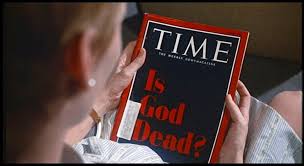
Abortion was a topic not much discussed in polite company back before the movements towards change in the 60’s and 70’s. It was practically a taboo word, only whispered by mothers gossiping about some unfortunate neighbor’s daughter. In the film ‘Rosemary’s Baby’ the word is spoken twice within a few seconds, which in itself was quite significant for the time of it’s release. Of course even this splinter of dialogue takes place in a scene within which a few women are speaking privately in a kitchen, in hushed voices and with the doors secured. We are given even deeper insight into Rosemary’s thought processes in the final pages of the novel where Rosemary, after the diabolical revelation of the baby’s paternity, considers throwing first the baby and then herself out of the seventh story window. “Choosing life,” to use a pro-life phrase, had never before had quite the same dire intimations. Abortion, Suicide and Satan are all a part of the spell conjured by Ira Levin’s novel and Roman Polanski’s faithful cinematic version of it. I have elucidated a few of these aspects of the book and film in this article: Sympathy for the Devil: The Sublime Satanism of ‘Rosemary’s Baby’
Maybe that’s all a bit heavy. Plenty of people enjoyed ‘Rosemary’s Baby’ the film as art, and rightly so. It is still widely considered to be not only Roman Polanski’s masterpiece but a watermark in cinematic history, and not only for suspense and horror. It is quite possibly the best horror film ever made. The seamless hand-held camera work, the realistic performances, the perfect casting, the elaborate sets, the 60’s fashions, and the understated horror of it all weaves an effective spell that has rarely been rivaled in cinema since it’s release in June 1968. It has been critiqued, studied, and analyzed; it was also condemned by the National Legion of Decency.
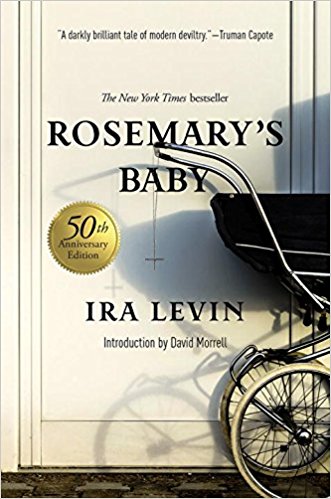
Cover for the 50th anniversary edition
Yet, despite it’s Hellish premise, ‘Rosemary’s Baby’ is not without it’s own darkling undercurrent of black humor. Even as Rosemary’s painful pregnancy intensifies and the stranglehold of suspicion and paranoia increases into a palpable threat, there is a snide kind of wit that permeates the film, like a chalky under taste, right up to the very denouement. New York City in the Swinging Sixties – the materialistic agnosticism of urban culture influencing the good Catholic school girl from Omaha. The strange neighbors all but hiding behind carnival devil masks. Rosemary’s husband Guy Woodhouse is an aspiring actor focused on name, fame and wealth: he’s a materialist interested in the supernatural only for whatever material benefits can be gained by it. He makes fun about seeing the Pope performing a Mass at Yankee stadium on TV: “That’s a great spot for my Yamaha commercial,” he laughs, shortly before pimping his wife out to You-Know-Who. It’s the film’s realism, along with a judicious use of subtle irony and sly wit, that makes the psychological terror all the more palpable.

L to R: Bruno Sidar as Mr Gilmore, Patsy Kelly as Laura Louise McBurney, Charlotte Boerner as Mrs Leah Fountain, Almira Sessions as Mrs Sabatini with her cat Flash.
And we can’t help but relish Minnie and Roman Castevet and the other lurid characters surrounding Rosemary. Polanski mostly cast theater people and prolific film extras in these roles as witches, so we get an odd feeling of something not-quite-right and familiar about them at the same time. Ruth Gordon won the Oscar for Best Supporting Actress for her portrayal as Minnie Castevet; a role she killed – leaving it impossible for anybody to match it. It is fun to think of the Castevets and some of the other extras as demons trying (a little too hard) to pass themselves off as human. We smirk at the irony of a young, naive first-time mother’s helplessness before a coven of smiling, well-meaning old geezers who are (she thinks) plotting against her and her baby. And, when there are no witches hovering around Rosemary, there are several authoritative men “mansplaining” things to her.
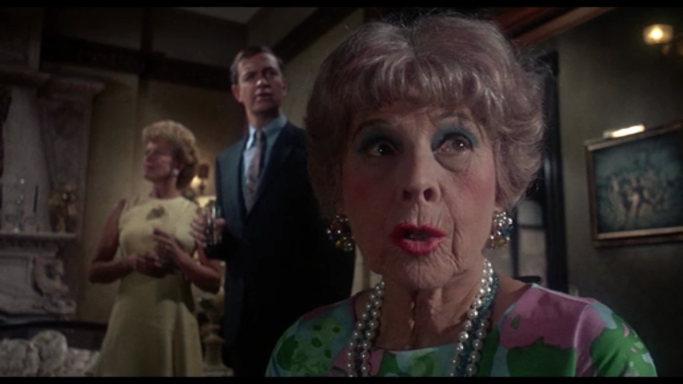
“look at his hands!” Ruth Gordon as Minnie Castevet.
Want to know more about the witches in ‘Rosemary’s Baby’? Read our article: All of Them Witches: A ‘Who’s Who?’ in ‘Rosemary’s Baby’
Read our Interview with cast member Ernest Harada who appears in the film’s climax: An Interview with Ernest Harada: Celebrating 50 Years of ‘Rosemary’s Baby’
The deal is made with the Devil of course, but Rosemary, ignoring warnings from a dear old friend, has already sold her soul (and good sense) by falling in love with the old apartment building’s gothic charm and by begging her ambitious actor husband Guy to get them out of “the other lease” in order to take the apartment in the looming Bramford (need we mention the infamous Dakota where the exterior shots were filmed?). After moving in she does her best to redecorate the rather solemn interior with white and yellows; but as Rosemary remakes the Bramford’s interior to suit her tastes, the Bramford remakes Rosemary’s interior to suit it’s own sinister plans. That’s because Rosemary’s metamorphosis is America’s metamorphosis. Innocence is lost. Once the post WWII “high” of the 1950’s and ’60’s faded, the public grew numb after numerous political and social upheavals, celebrity deaths and the consumer complacency which ushered in the 1970’s. Off come the pig tails, gone is the girlish smile, and a pain – “like a wire inside of me getting tighter and tighter” as Rosemary laments – settles in our core.
We can argue that things are still changing drastically today, perhaps in even more ways than they were in ’67. ‘Rosemary’s Baby’ is now 50 years old and still walks among us like a smug iconoclast at a cocktail party – sneering and scoffing at our outmoded ideas regarding religion or morality – wearing a cheap Halloween Boogey-man mask as he laughs at our nervousness at letting go of our old fears and inhibitions. And yet we wonder after the final revelation at the end of the story: is it a happy ending or a terrifying one? The answer of course is “Both.” Rosemary’s baby is alive, safe, adored, worshipped; but that in itself spells certain doom to the world we know, or at least to the world we used to know “back then.”
– H.B. Gardner
